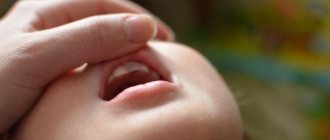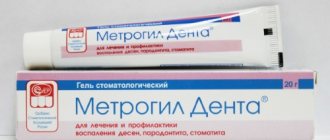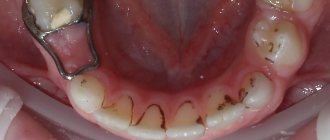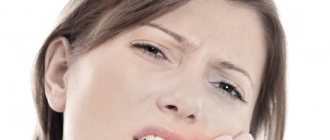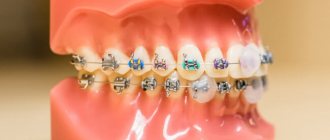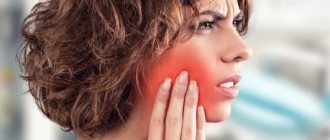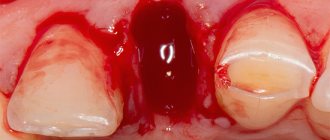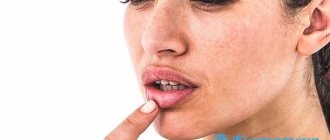Characteristics of types of bruises
Treatment of bruises is carried out after assessing the severity of the injury. Characteristics of types of bruises:
- In grade 1, the patient experiences minor pain, which may intensify with pressure on the damaged area. Damage to the skin in the form of small scratches and abrasions is allowed. Bruises go away on their own within 3-5 days.
- Grade 2 is characterized by a violation of the integrity of muscle tissue. The patient experiences severe pain. Swelling and hematoma form at the site of the injury.
- At grade 3, the patient experiences a violation of the integrity of the skin, the formation of edema and severe bruising.
- At grade 4, damage to muscle, epithelial and nervous tissue is observed. After the blow, the injured area is paralyzed.
A bruise can be external or internal. In the first option, a change in skin color is observed. An internal hematoma on the cheek is accompanied by the appearance of a compaction in the tissues. The external characteristics of the epidermis are unchanged.
Symptoms of argyrosis
Argyrosis develops gradually. First, a characteristic grayish-brown discoloration of the gums appears, then hyperpigmentation and discoloration of exposed areas of the body. Later, hyperpigmentation of the sclera, nail beds and mucous membranes occurs; blue staining of internal organs, which was accidentally discovered at autopsy.
To confirm the diagnosis, a skin biopsy is performed and the resulting material is stained with hematoxylin and eosin.
Argyrosis is caused by significantly lower doses of silver than those that cause acute poisoning; The intensity of skin coloring is directly proportional to the amount of metal in the body.
As a rule, argyrosis develops when about 8 g of silver accumulates in the body, but there is a known case when argyrosis was caused by intravenous administration of 4 g of a complex compound of this metal with salvarsan (only 1 g in terms of metallic silver).
The color of the darkening varies from light gray to dark silver. The most pigmented areas of the body are those that are often open. Skin changes color:
- faces;
- neck;
- hands
Severe cases of pathology are accompanied by:
- acquiring a uniform dark silver color with a body sheen;
- noticeable deposits in the deep layers of the cornea;
- slight weakening of vision, which progresses as silver accumulates.
The tissues of the optic nerve and the retina suffer from an excess of the element, hemeralopia occurs and a significant decrease in visual acuity.
How to remove a bruise
If the bruise appeared on the cheek on its own, i.e. without tissue injury, this indicates that the patient has weakened vascular walls, and there is a lack of vitamins and minerals in the body. To choose the right treatment, you need to undergo tests prescribed by your doctor. Based on the examination results, appropriate medications will be prescribed. In addition to medications, it is necessary to correct the diet.
You can prevent a bruise from appearing immediately after an injury by applying a cold heating pad to the injured area. Ice can be used, but it must first be wrapped in several layers of fabric. If it was not possible to prevent the appearance of a hematoma, you can remove a bruise from the face using the following medications:
Falls and injuries occur quite often in children. Sometimes, due to bruises, a hematoma appears on the baby’s face.
Of course, every mother wants to get rid of it as quickly as possible.
How to cure a hematoma on a child’s face, and whether it’s worth doing at all, we’ll look into this article.
Creams and gels for bruises
These remedies are also used quite often to eliminate hematomas. They contain active extracts that help clear the skin of bruises. These products are also well distributed on the skin and are absorbed fairly quickly, as a rule, leaving no traces.
Creams are more suitable for babies with dry skin. Gels can be used in cases where rapid absorption is required.
The healing properties of leeches for resolving various bruises have been known since ancient times. This is due to a special substance hirudin . It is secreted by leeches when they bite through the skin.
This substance is necessary to prevent blood from clotting. Adding hirudin to drugs allows you to achieve a thrombolytic effect.
Bruise-OFF
Leech extract is contained in the “Bruise-OFF” gel. This drug is applied to the site of the resulting bruise. Regular use of this product helps cleanse the skin quite effectively. You can anoint it on almost any area of the skin where such changes have appeared. This drug also improves the healing and restoration of damaged skin.
According to the mechanism of its action, the gel “Bruise off” is somewhat reminiscent of heparin ointment. Both of these drugs have a fairly strong effect on hematomas. Within a few days you can notice a positive effect. This remedy can also be used for abrasions. In some cases, treatment may take 5-7 days.
This product can also be used to restore the skin after surgical or trauma operations.
This drug has a number of contraindications for use. It should not be used in children with severe diseases of the blood or hematopoietic organs. In this case, before using the gel, you should definitely consult a pediatrician or hematologist.
The presence of an allergic reaction to leech extract is also a contraindication for the use of this product. This medicine is usually prescribed for babies older than 6 months.
Rescuer
“Rescuer” is a balm that has a fairly good composition of biologically active components.
All chemicals are of natural origin. Ingredients include: milk lipids, beeswax, lavender oil, antioxidants and vitamins, tea tree oil and sea buckthorn and many others. This complex composition allows the product to be used for a wide variety of pathologies. Most often, this drug is used to treat hematomas, as well as other traumatic injuries.
This product can be used even in the youngest patients, since it does not contain any antibiotics or aggressive components that cannot be used in pediatric practice.
This medicine can be applied to shallow skin lesions, as well as various abrasions or scratches that occur at the site of injury.
Many mothers use “Rescuer” to treat diaper rash in infants or to eliminate redness of diaper dermatitis. It is better to use this product after daily hygiene procedures.
The balm can also be used to treat frostbite or burns. This tool has a fairly wide range of actions.
What is a hematoma?
A hematoma is an accumulation of blood in the upper layers of the skin, which occurs due to a violation of the integrity of the blood vessels. Occurs as a result of injury, bruise or blow.
There are the following types of hematomas:
- Light hematomas. This type usually does not appear immediately and can be found on any part of the face. When pressure is applied, the child feels pain; the bruise after a bruise goes away on its own within a few days. To speed up the process, ointments or cold compresses are sometimes applied to the affected area.
- An average hematoma appears after a few hours. This is characterized by significant swelling and severe pain. In such cases, treatment with special medications or the use of folk remedies is allowed.
- Severe form. In this case, the bruise will be clearly visible within an hour. The pain is constantly increasing. In severe cases, you should definitely consult a specialist, since in some cases even surgical intervention will be required.
Treatment with folk remedies
In some cases, traditional methods of treatment are also suitable, which can be used for both children and adults.
Traditional medicine advises applying a cabbage leaf to the hematoma several times a day. Before this, you need to beat it slightly so that the juice comes out better.
You can use any clay. To do this, you need to soak it for 5 minutes, squeeze it out, wrap it in cotton cloth and apply it to the site of the bruise.
You need to keep this compress for at least 30-40 minutes and repeat the procedure several times a day.
Salt is the simplest and most effective remedy for bruises. You need to make a strong saline solution, soak gauze in it and apply it to the hematoma. The solution will penetrate the skin through the pores. It is important to cover the top of the gauze with a warm scarf. You need to hold the compress for 10-15 minutes, after which the bruise begins to resolve and the pain goes away on its own.
You can apply an ordinary lead coin to the site of the injury. Grandmothers say that such a simple remedy will help get rid of a bruise in record time.
Take regular potato starch, dilute it with water to make a paste, apply to the bruise for 10 minutes. You need to do the procedure several times a day.
Most traditional methods for treating hematomas cannot be used to treat small children, especially if the bruise is on the face.
Be careful, it is better to consult a doctor before starting treatment so as not to aggravate the situation even further.
Ointments for bruises and bruises
Bruises on a child’s skin can be treated with a variety of means. Currently, there are a huge number of different pharmacological drugs that are sold in any pharmacy. You can also cleanse your skin using some folk tips and recipes. In this case, you should definitely consult with your doctor , since the baby may have contraindications to any method of alternative medicine.
The first aid for traumatic bruises on the skin is the application of cold . This simple measure can significantly reduce the damage area. Cold causes a pronounced spasm of blood vessels, which helps reduce the size of the bruise.
In this case, a hot bath or sauna is completely excluded, as it can only lead to a worsening of the general condition and the spread of bruises throughout the body.
Treatment of hematomas on the torso in children should be differentiated. You cannot treat a baby with the same methods as a teenager. For very young patients, medications are used taking into account their age. The daily dosage of drugs should not be exceeded.
Medicines for hematomas can be produced in a variety of forms. Quite often children use ointments. These medications, used for topical treatment, are well distributed over the skin and are absorbed fairly quickly. They should be applied, as a rule, 2-3 times a day (according to the instructions for the drug). Some of these remedies can also be used in babies under one year of age.
Heparin ointment
Heparin ointment is a well-known medicine that is known in almost every family. Heparin, which is part of the drug, has a resolving effect. It helps dissolve bruises and cleanse the skin.
Before using this drug, you should first test to determine an allergic reaction. To do this, a small amount of ointment is applied to a limited area of skin. After 15-20 minutes, there should be no red or itchy elements in this area.
Heparin ointment is usually prescribed for use 2-3 times a day. This remedy can also be used for other injuries that are accompanied by the development of abrasions or bruises on the skin. It should only be applied to clean skin. After application, hands should be rinsed thoroughly under running water.
Parents should remember that this ointment should not be applied to open or bleeding wounds. Such use can only lead to increased pathological bleeding.
The use of heparin ointment in young children is limited. This drug is prescribed only by the attending physician after examining and examining the child and identifying possible contraindications.
Some pediatric traumatologists recommend placing a piece of ice wrapped in a cloth on the bruise before applying the ointment. This compress should be kept on the skin for 10-15 minutes. This will help relieve severe inflammation and reduce the appearance of swelling of surrounding tissues.
When choosing a product, you should pay attention to the biologically active components it contains. Most of these medicines contain a large number of different herbal components. Such extracts may cause an allergic reaction in a child who is hypersensitive or prone to allergies.
Before using these products on their own, parents should always consult with their doctor.
Troxevasin
Currently, there are a huge number of different medications that have a pronounced absorbable effect on bruises. One of these drugs is Troxevasin.
The components included in its composition help to clear the skin of bruises very effectively. This fast-acting remedy is suitable for treating many traumatic injuries. To achieve the effect, you should use this medicine several times a day.
Troxevasin is used quite successfully to treat bruises that appear on a child’s legs. This remedy can also be used even if the baby has signs of chronic venous insufficiency.
Doctors prescribe this drug to children over one year of age. In some cases, using the product may cause your baby to develop hives or itchy red rashes on the skin. In this case, you should not use this drug.
Dolobene
"Dolobene" is a drug that is available both as an ointment and a gel. The use of this remedy is used to treat many traumatic injuries. This drug can only be used in children over 5 years of age.
You can treat the affected areas with this ointment 2-3 times a day. The positive effect of use usually occurs within 3-5 days from the moment bruises appear on the skin. The complex composition of this drug allows you to successfully cope with any hematomas that are present on the baby’s skin.
Treatment of hematoma with a lump
Quite often, with a bruise of the frontal part and cheekbones, in addition to a bruise, a bump also appears, which also requires separate treatment and attention. Additionally, if the injury was significant, blood from damaged vessels may collect between muscle fibers or even around bone. These types of hematomas are considered the most dangerous.
In order to cure this type of damage, we recommend the following manipulations:
- If there is no wound and the skin at the site of the bruise is not damaged, you can draw an iodine grid. It promotes vasodilation and rapid blood flow.
- Apply Heparin ointment or Troxevasin.
- A compress with magnesium will help get rid of the problem perfectly. To do this, simply take a small piece of cotton wool, soak it in magnesium and squeeze it out. Secure it to the cone, change it every 2-3 hours as it dries. It is recommended to secure a light cloth on top of the compress, followed by a layer of cellophane. This way the compress will dry much longer and work better.
- If the site of the impact not only changes color, but also hurts greatly, you can use painkillers such as Citramon, Nurofen, Paracetamol or others, depending on the age of the child.
Diagnosis and treatment
Usually a bruise is diagnosed by external manifestations. They conduct an examination of the skin, oral cavity, palpation, and anamnesis. If a jaw fracture is suspected, an x-ray is taken.
First aid is to apply cold water to the damaged area. Cold constricts blood vessels, stopping internal hemorrhage. If the skin is cut, the wound is treated with an antiseptic.
Medicines that help relieve swelling: Troxevasin, Heparin ointment, Indovazin, Dolobene gel, ointments with arnica, larkspur. Folk remedies to reduce swelling:
- cabbage leaf with honey,
- compress of grated potatoes, boiled beans,
- iodine network.
The bruised area should not be heated. This causes inflammation. Massaging the tumor slows down vascular regeneration.
Types and causes of appearance
A bruise on the face can appear for various reasons. Most often, this is a bruise or injury resulting from a fight, beating, fall, accident, failure to comply with safety regulations, or an accidental impact on door frames or protruding corners of furniture. The cause of hematoma formation can be surgical interventions or complex cosmetic procedures.
Vascular ruptures and hemorrhages under the skin often worry people with bleeding disorders and fragile capillary walls.
In such patients, even a careless touch of the hands or a sharp turn of the head can provoke the appearance of a bruise.
The location of the bruise, its size and the presence of associated complications affect the duration and treatment regimen for the hematoma.
On the forehead
A hematoma on the forehead is the consequences of a blow to the frontal part of the skull. Most often, such injuries occur in restless children exploring the world around them. Cases of painful bumps and bruises in adults are the result of a collision with a hard surface or heavy object.
Strong blows to the head can cause a concussion. If, in addition to a bruise and swelling on the forehead, a person has convulsions, nausea or vomiting, vision has sharply decreased, lips have turned blue, consciousness has become confused, and movements have been inhibited, it is necessary to urgently go to the hospital.
Under the eyes
Subcutaneous hematomas under the eyes can be the result of a blow to the bridge of the nose, temple, or directly to the eye area.
Damage to the walls of blood vessels can occur without traumatic exposure. Dark circles under the eyes are more likely to appear in people with fragile capillaries located under the skin.
On the cheeks
A bruise on the cheek most often appears after a blow or dental procedures.
A similar complication can be caused by a pain-relieving injection into the gum or removal of a wisdom tooth.
On the lower jaw
A hematoma on the face from a blow to the jaw is often accompanied by impaired function of chewing and swallowing food. Bruises on the lower jaw can appear after unsuccessful tooth extraction, a fight, or a domestic or work injury.
Human perception of the color blue
We compare the color blue to the color of the night sky; we perceive it as velvety, dark, deep and mysterious. Since ancient times, it was considered the color of the soul and God.
Sacred objects in temples and monasteries were covered with blue, and priests dressed in blue clothes. It promotes inspiration and reflection, the emergence of innermost desires, and evokes thoughts about one’s own soul and the meaning of life. This is the color of the development of human spirituality, where faith and intuition predominate, and reason is in the background.
This color is cold and hard. Promotes the development of will and determination, self-confidence, forms one’s own views on life, which sometimes do not fit in with real life.
Believing in your own beliefs often conflicts with what is happening around you. A person who loves blue color strives for management and leadership, imposes his opinion on others and is upset when he is not accepted.
When blue predominates in a person, and other colors are suppressed, the person becomes dry and stiff, and diseases of radiculitis and osteochondrosis, inflammation of the joints may occur.
When blue is in harmony with other colors, a person becomes understanding, sociable and contactable. Ultimately, this leads to the renewal of the body’s energy and healing from many diseases, which is how the influence of blue color on health is manifested.
An important feature of this color is that blue helps a person penetrate into the essence of things, absorb new information, carry everything through himself and convey it to people in an accessible form. This is the color of insight and genius.
Light blue shades or blue color instill carefree fun in a person, dark blue leaves an imprint of satisfaction and deep peace. When sick and overworked, the need for blue increases.
Ultramarine or indigo color helps to improve the health of all organs of the head: ears, nose, eyes, teeth... this shade of blue keeps a person in constant good shape and its excess can lead to sadness and sadness.
Blue color therapy
Since the blue spectrum is considered the color of peace and tranquility, in color therapy it is recommended for relaxation, relieving nervous tension, restoring strength and energy, and treating insomnia.
- Blue color, affecting human health, slows down all vital functions,
- establishes closer contact between consciousness and subconscious,
- enhances the process of self-hypnosis and hypnosis,
- promotes the ability to control oneself,
- heals the respiratory system, skin, is especially effective for diseases of the upper respiratory tract, bronchitis and lungs,
- has a beneficial effect on the functioning of the thyroid gland,
- slows down bleeding and promotes wound healing.
- Blue color relieves psycho-emotional stress, removes aggression, fear and anxiety. Calms breathing and lowers blood pressure. People with manic psychosis, placed in a blue-lit room, quickly calm down and get better.
- Experts recommend it to women during menopause and menstrual irregularities.
An excess of blue causes negative reactions, boredom, fatigue and melancholy, anxiety and doubt may appear.
How to remove a hematoma from the face
Treatment of a hematoma on the face should be carried out according to a special scheme: on the day of injury, it is recommended to apply cold compresses, and the next day to begin warming up the bruised area. It is recommended to combine heat compresses with medications or folk remedies that have a resolving, healing and analgesic effect.
Cold treatment
Before removing a bruise on the face, cold should be used as a first aid measure. To make a hematoma on the face after a blow less “picturesque”, you should apply ice wrapped in a thin cloth to the site of the injury as soon as possible. If there are no ready-made ice cubes in the refrigerator, any frozen food (meat, processed foods, vegetables, berries), a bottle of ice water or cold metal objects (coin, spoon, etc.) will do.
